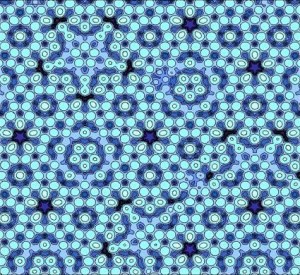SUNDAY, 9 OCTOBER 2011
Crystals are solids that are periodic – they have a regular, repeating structure in three dimensions. This periodicity means that they have both rotational symmetry and translational symmetry. If a crystal is rotated by a certain angle or moved in space by a certain distance, it will be indistinguishable from its starting position. Although quasi-crystals have long range order with many sub-structures that are repeated throughout, they do not have true periodicity. They can never be rotated or moved in such a way as to look exactly the same. Quasi-crystals can be best understood visually by referring to Penrose tiling or some Islamic designs, where there are recurring motifs and an underlying symmetry, but no true periodicity.The experiment that first put Shechtman onto the idea of a quasi-crystal was an electron diffraction study he undertook to investigate the structure of an aluminium/manganese alloy. Usually crystals have two-, three-, four- or six-fold symmetry, but the unusual diffraction pattern he obtained suggested that the crystal had five-fold symmetry. He did not think his findings were merely a fluke, but it was a long time before the scientific community accepted his conclusions. Quasi-crystals have subsequently been frequently studied, and could be important in the development of protective coatings and alloys. Dan Shechtman is currently at Technion, the Israel Institute of Technology.
Written by Stephanie Boardman
http://www.rsc.org/chemistryworld/News/2011/October/05101103.asp

